RESTORE THAT OLD DOG! WE BRING A 2006 YZ250F BACK FROM THE DUMPSTER
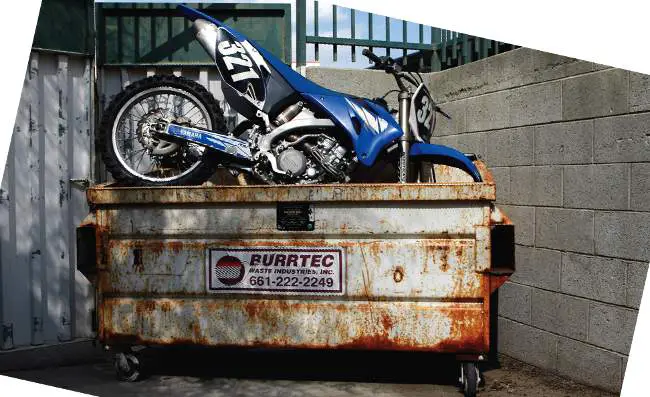
Home sweet home. The MXA wrecking crew dug it out of the trash heap, lavished it with beaucoup bucks and ended up with a new 2006 YZ250F.
This is a bike test unlike any other test that we have done in recent memory. The MXA gang is not test riding an uber-expensive factory machine, a big-bore fire breather or even a new 2012 bike. Nope. We have focused our attention on an old roach of a bike on the brink of death?a bike that was doomed to spend eternity collecting dust. And so goes the typical story of a blown-up four-stroke motocross bike.
We discovered this old 2006 Yamaha YZ250F in our buddy Jay Clark’s rotting shed. It was dead as a doornail and never going to run again?until we got the bright idea to see what it would take to restore that old dog. And, according to our grandiose plan, once we rebuilt it, we would race it.

Basket case? It’s never a good sign when your four-stroke engine looks like this.
The advent of the current four-stroke engine brought forth a revolution in motocross. For 40 years, the sport relied on two-strokes, but the dawn of the valve-and-cam engine sent racers into a whirlwind. In the span of eight years, four-strokes overthrew two-strokes as the most popular bikes on the track. Sadly, the life span of a four-stroke?especially early models?is significantly shorter than that of a two-stroke. Droves of riders have a nasty taste in their mouths from their four-strokes going up in smoke. In a fraction of a second, a four-stroke can suck a valve, stick a ring or break a crank without warning. And then, nothing. No more riding. No easy solution. And many of these poor saps don’t have enough money to repair their steeds.
Imagine that you worked extra hours and skipped a few meals to save enough money to buy a brand-new four-stroke. All of your buddies are jealous, but they warn you of the impending day that your prized four-stroke will belch its last breath. You laugh, because you’re a decent mechanic. You perform oil changes and air-filter cleanings with regularity. There’s no way that your $7000 investment will turn on you like a deranged dog. Then, 20 hours into riding, the bike locks up. What do you do? Should you spend $1000 repairing the damage? Should you sell the bike as is? Or should you push the bike into a dark corner of your garage and hope that the MXA wrecking crew comes five years later to fix it for you?

The intake valve wedged into the top of the piston when it broke, causing catastrophic damage.
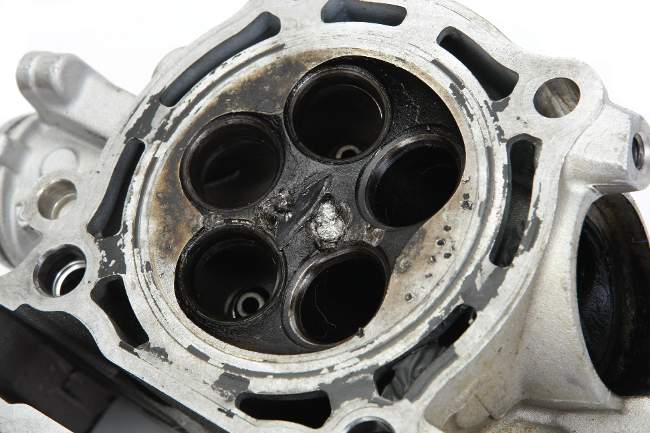
The broken intake valve also left its impression on the cylinder head.
This is a tough time in motocross. The introduction of new technology is baffling; bikes are rapidly turning into high-tech computers. When was the last time you took your cell phone apart to replace the CPU (do you even know what a CPU is)? Our point exactly. The same can be said for EFI, DFI, TPS and all of the other newfangled acronyms. For most people, working on a four-stroke is like cracking a safe. Valves, camshafts, shims, retainers, bearings, timing chains?it’s enough to make your head spin.
Riders with deep pockets have their bikes serviced by a local shop (mechanics charge around $100 an hour for labor). Depending on the extent of the damage to the cases, you’re looking at spending up to $3000 to repair a blown-up engine.

Before: Left to rot in a shed, MXA rescued this 2006 YZ250F and nursed it back to life. It took time, effort, and plenty of money. Was it worth the investment? You decide.

After: Aside from aesthetics, MXA’s rebuilt YZ250F received several key aftermarket modifications to make the bike competitive with the current crop of 250 four-strokes.
Which leads us to the 2006 YZ250F in Jay Clark’s shed. As it sat, it was worth about $500 on Craigslist. And that assumes that most of the parts could be salvaged for other uses. So, when the MXA gang took a close look at Jay’s trashed YZ250F, we quickly realized that $500 was too generous a price for a bike that looked bad and had a broken intake valve.
The broken valve was no surprise. The 2006 Yamaha YZ250F was infamous for its intake valve issues. We had blown a valve on our original 2006 YZ250F after only a few hours. At the time, Yamaha addressed the problem by issuing a recall to fix all the intake valves, but apparently the bike in Jay’s shed failed to get the memo.
SHOP TALK: SURVEYING THE DAMAGE
The valve was a major issue, but the rest of the bike was a disaster as well. The previous owner, and we could never find out who that was, had lots of free time on his hands, because he obviously didn’t spend any of it changing the oil, cleaning the air filter, adjusting the chain, or tightening (or loosening) the nuts and bolts.
This was a neglected bike?and a poor choice for us to use as a restoration project. But, once you start, you have to follow through. We soon discovered that the broken valve was only a small part of the engine problems. The crank was shot, and the head was damaged by the valve, as was the piston. You couldn’t have done more damage with a stick of dynamite.
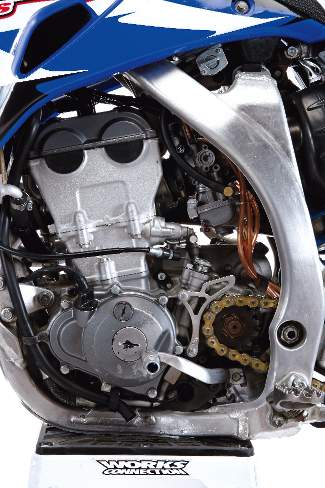 The 2006 YZ250F had a bad intake valve. A recall was issued, but the former owner apparently didn’t check his mailbox. |
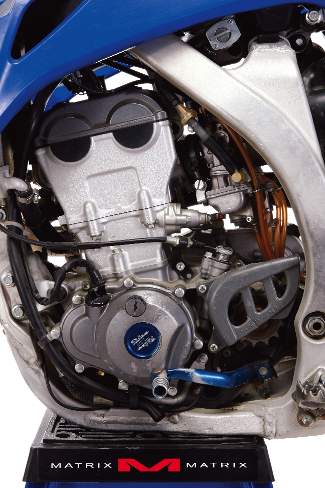 There are $1520 worth of new parts inside this engine. Just like a supermodel in a snowsuit, looks can be deceiving. |
The MXA gang was on a budget?at least we thought we were. Take a lesson from us, basket cases some times escalate into NASA-style black holes. Had everything gone right, we could have done this cheaply. To get started, we sent the thrashed cylinder head to Millennium Technologies for repair. Why didn’t we just scrap the stocker and start with a new head? Price, and price alone. A new stock head is expensive, but for $349.95, Millennium would weld up the head damage, recut the chamber, and install new valve seats and guides. The price didn’t include the cost of replacement valves. Normal turnaround time on the head job is seven working days at Millennium Technologies.
We dreaded the cost of a new crank, but we perused our options and settled on a Hot Rods crankshaft with the stock stroke for $274.95. Sadly, we also needed new main bearings and seals ($72.95), a forged Vertex racing piston ($194.20), Cometic top-end and bottom-end gasket kit ($94.95), Uni air filter ($26.95), and Yamaha OEM valves, springs, retainers and buckets ($500). The grand total for the engine parts alone was $1520, and that didn’t include the labor, which we made Jay Clark do for free. Our $500 barn-find had cost us $2000?so far.
If you look at the photos, you will see that our 2006 Yamaha YZ250F project bike looks completely different from the way the bike started out. That’s because we spent money on it?money that we could ill afford to waste on a five-year-old bike. The lucky recipients of our rapidly diminishing bank account balance were Race Tech (suspension), DeCal Works (graphics), Renthal (sprockets and chain), Pivot Works (steering stem bearing kit) and FMF (stainless steel Powercore 4 slip-on exhaust).
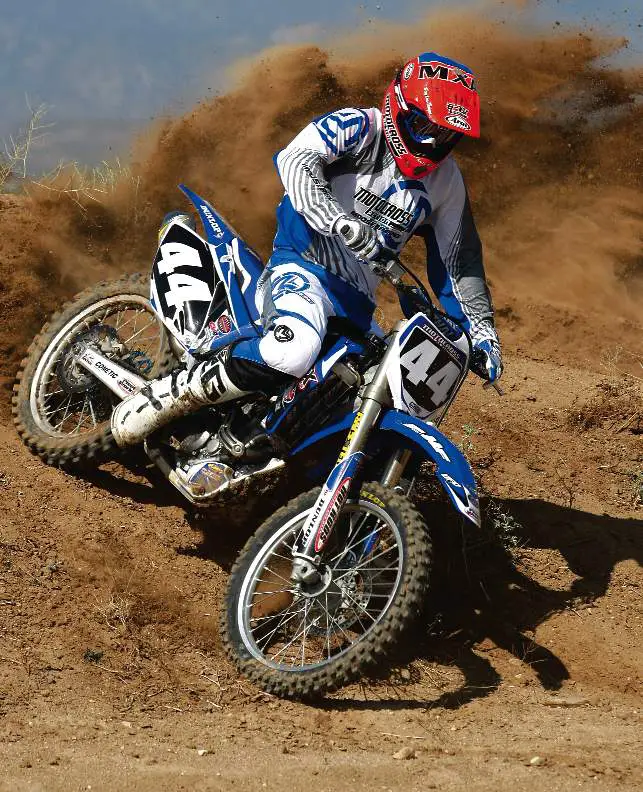
The rehabilitated Vertex/Hot?Cams Yamaha YZ250F proves that there’s life for a four-stroke after it gives up the ghost.
The suspension cost us $175 for oil and seals. The Renthal sprocket combination set us back $64.95 for the rear and $25.95 for the countershaft sprocket. The badly needed new Renthal R1 chain was $81.95. Since the stock head pipe was still in good shape, we went with a $299 FMF slip-on exhaust pipe. These must-have items added another $825 to the price tag. At $2850, this project was rapidly approaching Defcon 4.
The bad news kept coming. The cables were worn out, the bars were bent, the grips had rotted, the tires were shot, the clutch lever was bent, the plastic was faded and the seat cover was decrepit. Motion Pro provided new cables, Renthal supplied TwinWall bars and grips, and we mounted Dunlop MX51 tires. We had to replace the complete clutch-lever assembly with a Works Connection Elite clutch perch and order all-new UFO plastic. This last batch of parts was $600.
The grand total was now $3450 (including the $500 for the basket case we started with). We threw in an extra $200 on miscellaneous foofaraw and taxes. Thus, we spent $3650 on our 2006 YZ250F.
TEST RIDE: RAISING THE DEAD
Keep in mind that we just wanted to restore an old dog into a rideable and raceable motocross bike…at a bargain price. We were under no illusion that our ’06 YZ250F would be anything more than a reliable stocker with a few aftermarket parts?and that is all it is. The goal was simply to bring a dead bike back to life. Having said that, the MXA wrecking crew expected a bike that was restored to its 2006 glory. Most test riders had forgotten how good the 2006 Yamaha YZ250F was (even though the 2006 KX250F won the MXA shootout that year). We were pleasantly surprised with the engine performance of the YZ250F. The bike was competitive with newer-model 250 four-strokes right out of the gate. Several MXA test riders even preferred the powerband of the 2006 model to the 2011 YZ250F engine. Better yet, the engine held strong through repeated use and abuse. Riding our Millennium/Vertex/Hot Cams engine brought back fond memories and reminded us why we were so impressed with the YZ250F five years ago.

Once we figured out that the carburetor was full of varnish from old gasoline, we cleaned out the Keihin and enjoyed the engine characteristics.
Could we have saved more money? We could have, but it would have been penny wise and pound foolish. We tried to spend our dough on what we felt we had to have. The forks and shock needed to be rebuilt. The sprocket and chain had sat in a shed for five years, but looked like they had been spinning the whole time. The steering head bearings had to be replaced?unless we wanted to go in a straight line forever. And, the graphics, plastics, seat cover, handlebars and grips were stuff we had to do to live with ourselves.
CONCLUSION: WHAT DO WE REALLY THINK?
As we scanned the want ads looking for other 2006 YZ250Fs, we realized that we could have bought them for about what we spent?except that we know that everything on our bike is in working order. Buying used is always a crapshoot. We skipped the crapshoot part by starting with a bike that was destined for the landfill. This is a project for a guy with a modicum of mechanical skill, or, at the very least, a screwdriver and an owner’s manual. Our 2006 Yamaha YZ250F is back where it belongs?at the racetrack.




Comments are closed.